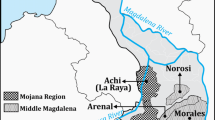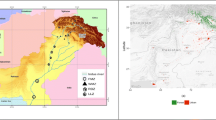Abstract
Past mining activities in the county of Cornwall in the United Kingdom, has exposed the local environment to raised levels of As. Previous research has shown an increased concentration of As in crops grown in such areas and the subsequent take-up of As through the food chain may lead to an increased body burden in man. In an attempt to evaluate this, a pilot study was carried out using Particle Induced X-ray Emission to compare the hair As concentration of a group of Cornish residents to that of a control group consisting of residents in the counties of Oxfordshire and Wiltshire. The null hypothesis being that there is no significant difference between the hair As concentrations of the two groups.
Each group comprised thirty six age and sex matched subjects. The mean hair As concentration for the Cornish group was 2.51 μg g-1, which is significantly greater than that of 0.7 μg g-1 found in the control group (p = 0.004). The World Health Organisation suggests a hair As value greater than 1 μg g-1 as evidence of increased exposure to As and 5 μg g-1 is quoted by the Canadian Government as evidence of significant ingestion of As. Twenty one Cornish subjects registered a value at or above 1 μg As g-1 compared to nine in the control group (p = 0.0003). Five subjects in the Cornish group had values that exceed 5 μg As g-1, compared to only two in the control group (p = 0.23). We use the results of this study as evidence to support our continued work in this area in order to evaluate possible health implications.
Similar content being viewed by others
References
Agency for Toxic Substances and Disease Registry. (1989): Toxicological Profile for Arsenic. ATSDR. Atlanta.
Barton. D. (1970): Essays in Cornish Mining History. Volume 2. Bradford Barton Ltd. Truro.
Cranton. E, Bland. J, Chatt. A, Krokovitz. R & Wright. J. (1982): Standardization and Interpretation of Human Hair for Elemental Concentrations. Journal of Holistic Medicine. 4. No 1. Spring/Summer 1982. p10–20.
Cullen. W. Reimer. K. (1989): Arsenic Speciation in the Environment. Chemical Reviews. 89. No. 4. p713–760.
Davies. B. (1983): Heavy Metal Contamination from Base Metal Mining and Smelting: Implications for Man and his Environment. Applied Environmental Geochemistry. Academic Press. London.
Dabeka. R. McKenzie. A. Lacroix. G. Cleroux. C. Bowe. S. Graham. R. & Conacher. H. (1993): Survey of Arsenic in Total Diet Food Composites and Estimation of the Dietary Intake of Arsenic by Canadian Adults and Children. Journal of Association of Official Analytical Chemists. 76. No.1. p14–25.
Emsley. J. (1985): Whatever Happened to Arsenic? New scientist. 19/26 December. p10–14.
Hamilton. E. Minski. M. (1973): Abundance of the Chemical Elements in Mans Diet and Possible Relations With Environmental Factors. In: Environmental Health Criteria 18-Arsenic. WHO. Geneva.
Larsen. E, Moseholm. L & Nielson. M. (1992): Atmospheric deposition of Trace Elements Around Point Sources and Human Health Risk Assessment II. Uptake of Arsenic and Chromium by Vegetables Grown Near a Wood Preservation Factory. The Science Of The Total Environment. 126. p263–275.
Lane. D.W, Duffy. C.A. (1996): The Analysis of Trace Elements in Human Teeth Collected From The Oxfordshire Area in The UK. Nuclear Instruments and Methods. B118. p392–395.
Lane. D.W, Peach. D.F. (1997): Some Observations On The Trace Element Concentrations In Human Dental Enamel. Journal of Biological Trace Element Research. 60 p1–11.
Li. X, Thornton. I. (1993): Arsenic, Antimony and Bismuth in Soil and Pasture Herbage in Some Old Metalliferous Mining Areas in England. Environmental Geochemistry and Health. 15. (2/3) p135–144.
Liebscher. K. Smith. H. (1968): Essential and Nonessential Trace Elements. A Method of Determining Whether an Element is Essential or Nonessential in Human Tissue. In: Health Criteria 18-Arsenic. WHO. Geneva.
Ministry of Agriculture, Fisheries and Food. (1984): Food Additives and Contaminants Committee Report on the Review of the Arsenic in Food Regulations. Her Majesty's Sationary Office. London.
Nielsen. F. (1991): Nutritional Requirements for Boron, Silicon, Vanadium, Nickel and Arsenic: Current Knowledge and Speculation. FASEB Journal. 5. p2661–2667.
Nielsen. F. (1993): Ultratrace Elements of Possible Importance for Human Health: An Update, in Essential and Toxic Trace Elements in Human Health and Disease: An Update. Wiley-Liss Inc. p355–376.
Shanghai Institute of Nuclear Research. (1988): Certified Reference Material: Human Hair. Academia Sinica. Shanghai.
Smith. A. Hopenhayn-Rich. C. Bates. M. Goeden. H. Hertz-Picciotto. I. Duggan. H. Wood. R. Kosnett. M. Smith. M. (1992): Cancer Risks from Arsenic in Drinking Water. Environmental Health Perspectives. 97. p259–267.
Smith. J.R. (1994): Personal Communication. Cornwall Archeological Unit. Cornwall Country Council.
World Health Organisation: (1981). Environmental Health Criteria 18-Arsenic. WHO. Geneva.
Author information
Authors and Affiliations
Rights and permissions
About this article
Cite this article
Peach, D., Lane, D. A Preliminary Study of Geographic Influence on Arsenic Concentrations in Human Hair. Environmental Geochemistry and Health 20, 231–237 (1998). https://doi.org/10.1023/A:1006590827264
Issue Date:
DOI: https://doi.org/10.1023/A:1006590827264




